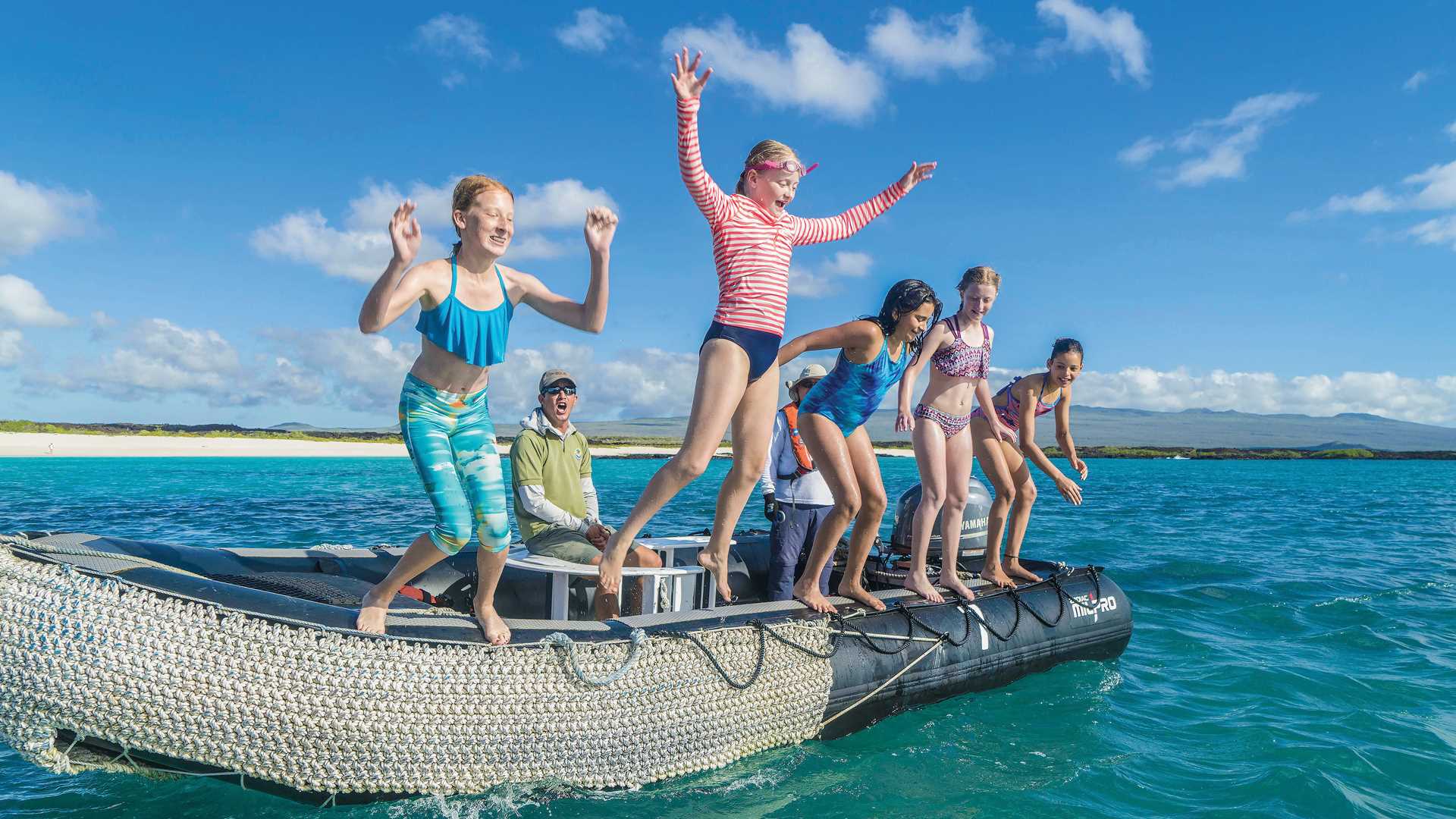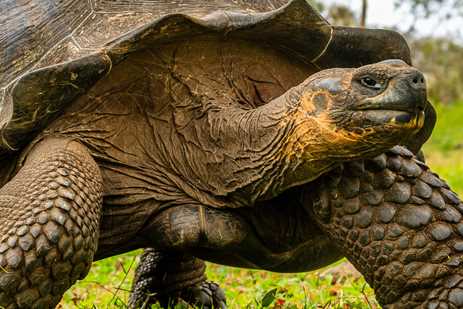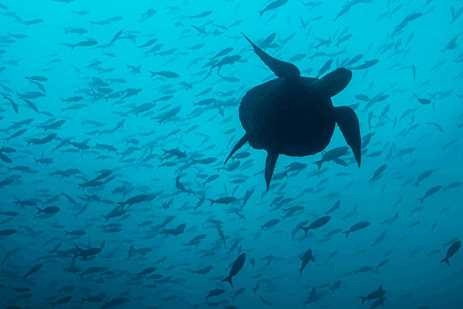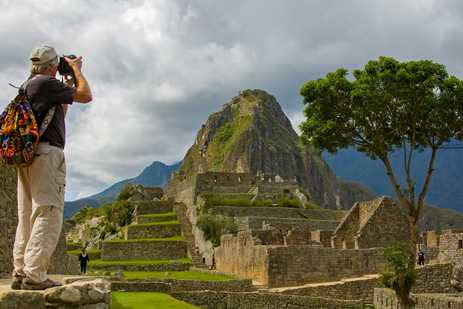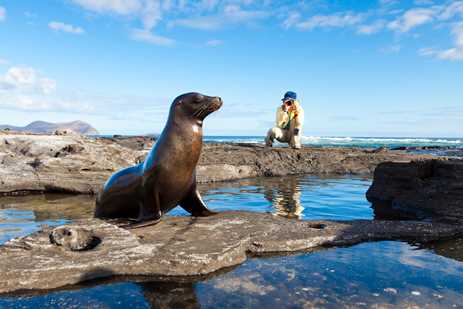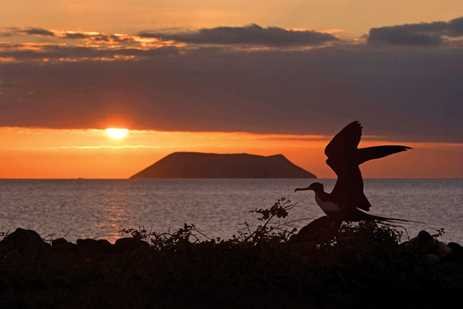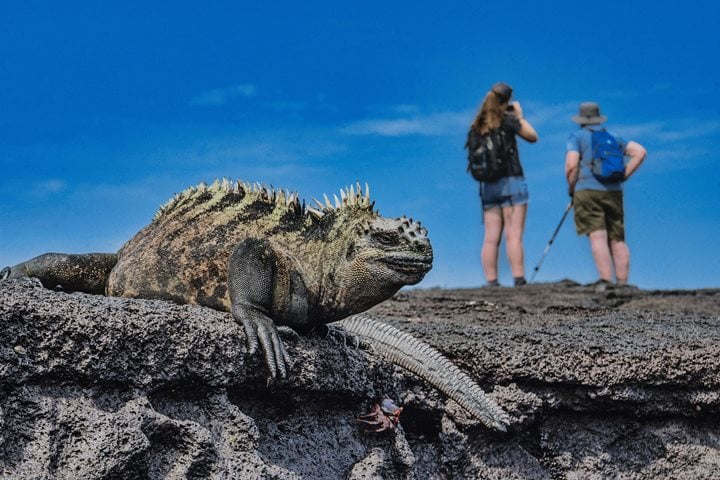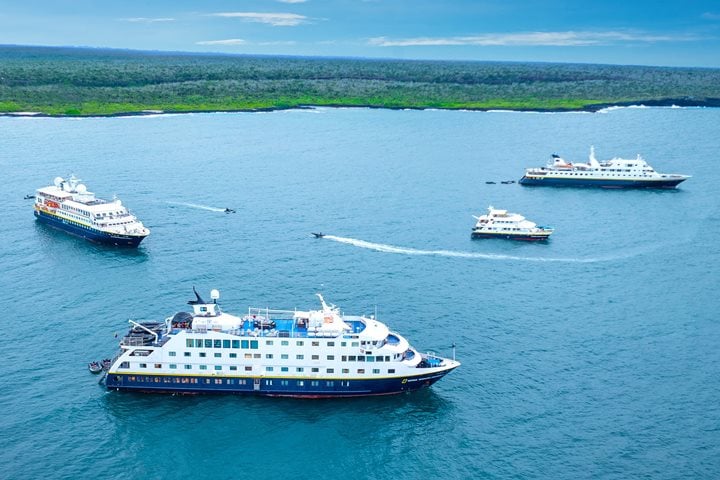Call +1.800.397.3348 or contact your travel advisor
Kayaking past playful sea lions, snorkeling with tiny penguins, spotting blue-footed boobies and hundred-year old tortoises—truly, what kid wouldn’t want to go to the Galápagos?
To put it simply: “Being a kid in the Galápagos is a lot of fun,” says Sven Lindblad, whose family pioneered travel to these legendary islands more than 50 years ago.
If you’re looking to bring your family to one of the most fascinating and unique places on the globe, look no further than the remote and highly protected Galápagos Islands, a world unto itself some 600 miles off the coast of Ecuador.
The island archipelago which Darwin put on the map is famous for its incredible creatures. Found nowhere else on earth, these endemic species are not just rare, but they’re also unfazed by humans. Since they evolved without land predators, they’re not afraid, which means kids can safely observe some of the most incredible birds and animals in the world from a close distance.
Plus, on a family trip to the Galápagos, everyone can participate in activities together, including hiking the volcanic landscapes and snorkeling and kayaking in the marine reserve.
Traveling to the Galápagos with Kids
If you’re considering traveling to Ecuador and the Galápagos with kids, you’ll be happy to know you’re in good company. Adventurous families have discovered that their young explorers thrive in the unfettered and naturally unplugged natural world here. As a result, the islands have become a popular destination during school vacation periods.
For example, during peak family vacation times, nearly 70% of guests aboard a Lindblad-National Geographic expedition have someone under 18 in their traveling party, making sailings during the summer and Christmas and spring breaks into amazing Galápagos family tours. These dynamic trips also provide the perfect setting for genuine family togetherness and creating unforgettable memories while witnessing the comical blue-footed booby mating dance and snorkeling with playful sea lions.
Is the Galápagos a Good Place for Kids?
Mostly uninhabited and teeming with remarkable wildlife, the legendary islands of the Galápagos will captivate kids of all ages on a family trip. No kid can resist the chance for incredible animal interactions–such as observing an almost unbelievable tangle of marine iguanas sunning themselves on the volcanic rocks and standing only a few feet away from the islands’ iconic giant tortoises.
Since Galápagos is right on the equator the weather is temperate year-round and there’s 12 hours of daylight every day, so kids can spend plenty of time outside where they can hike, swim, and snorkel everyday.
Plus, on a trip to the Galápagos with kids, almost everything you’ll do is unplugged. They’ll get out of their comfort zone and experience things they never could have imagined. Spending time in the water or hiking in lush highlands looking for giant tortoises leaves little time for texting or mindless scrolling.
What Age Should My Kids Be to Travel to the Galápagos?
The Galápagos Islands are a wonderful destination for children, but consider your child's interests and comfort level when planning. Although swimming isn’t a requirement, being comfortable in the water means the ability to snorkel on a trip, which is one of the best ways to explore this marine environment. If you travel to Galápagos with Lindblad Expeditions-National Geographic, you’ll also have access to glass-bottom Zodiacs (except aboard National Geographic Delfina) so even non-snorkelers can experience the incredible undersea.
Often, children aged seven and up will get the most enjoyment out of a Galápagos family vacation and be able to fully appreciate all the activities on board a ship, including dining with new people and interacting with guides and naturalists. They’ll also be able to handle the physical requirements of snorkeling, kayaking, and hiking. On a Galápagos family vacation with Lindblad Expeditions-National Geographic, when the action-packed days come to an end and the kids are ready to rest, parents can enjoy time on board with a cocktail in the lounge or a massage in the spa.
Depending on the company you sail with, age requirements may vary. On a Lindblad Expeditions-National Geographic voyage, all ages are welcome, including infants (there are even a limited number of cribs on board). Kids and teens can also participate in our exclusive National Geographic Global Explorers program which is led by Certified Field Educators.
Planning a Family Vacation to the Galápagos Islands
If you're thinking about planning a family trip to the Galápagos, there's a lot to consider: how long you want to go to, where to stay, how to get to the islands, how to explore them once you arrive, and more.
Deciding How Long to Visit the Galápagos with Your Children
When determining how long your Galápagos family vacation should be, first, think about how comfortable your children are being away from home (and how long they can be away before they start to hit a wall when it comes to having fun.)
Next, make a list of what’s most important for you to see on a Galápagos vacation. Are there wildlife experiences that are “musts?" Note that the islands are scattered across a wide area and each island provides new and different creatures to encounter, from flamingos to marine iguanas. Traveling aboard an expedition cruise allows you to see more of the wildlife that you and your children are excited about.
The travel company you choose also helps determine your length of stay. Depending on their offerings, voyages might be as short as four or five days or as long as 14 days. If time allows for your family, you might also consider taking back-to-back voyages to ensure you see as much of the islands as possible.
Learn more about how much time to visit the Galápagos.
Getting to and from the Galápagos with Your Kids
Almost all visitors arrive in the Galápagos by plane from mainland Ecuador. Daily flights depart from the two most populated cities in the country: Quito, the capital, located high in the Andes Mountains, and Guayaquil, on the country’s Pacific Coast. Most travelers will spend a night in one of these two mainland cities both before and after their visit to the islands due to flight schedules.
Everyone arriving in Ecuador needs a valid passport, but U.S. and Canadian citizens are not required to obtain a visa. However, everyone arriving in the Galápagos Islands needs to pay an entrance fee upon arrival, in cash, to the Galápagos National Park of $400 for adults and $100 for children under 12. Children under two are free. In addition, you must pay $20 to obtain a Galápagos Transit Control Card, payable in cash in the Quito or Guayaquil airport.
Traveling with Lindblad Expeditions-National Geographic is a seamless experience since our specialists will help every step of the way with everything from arranging transfers and flights to coordinating hotels on the mainland.
Here’s more about how to get to the Galápagos
How to Get Around the Different Islands with Your Family
There are 13 major islands in the Galápagos, plus dozens of smaller, less-explored ones, spread out across 23,000 square miles of ocean. Ninety seven percent of the archipelago is designated a national park and all but four of the islands are uninhabited.
There are very strict guidelines in place to protect the wildlife and these pristine habitats. Individuals are not allowed to visit the islands on personal watercraft; visits are only allowed with a certified tour guide, with one guide required for a maximum of 16 guests. And only the largest inhabited islands have commercial airstrips, so flying between islands is not an easy option, while traveling by speedboat can be uncomfortable.
That means traveling on an expedition cruise is the ideal choice for exploring with your family. Each night as you sleep, the ship will carry you from one place to the next, allowing you to reach remote islands like Fernandina and Genovesa. You’ll experience a diversity of wildlife and landscapes all interpreted by knowledgeable guides who are with you every step of the way.
Learn more about what islands to go to in the Galápagos.
Where to Stay on Galápagos Islands with Your Family
Staying on the islands is not as easy as it may sound. While there are a few islands in the archipelago like Santa Cruz, San Cristóbal, Isabela, and Floreana that allow overnight visitors, the options and availability are limited. Pair that with the fact that there are very few (and sometimes no) inter-island flights, and traveling by ship is the obvious choice for a Galápagos family getaway.
Best Times for a Family Vacation to the Galápagos
If you’re planning a trip to the Galápagos with your family, there’s good news: It’s always a good time to visit these special islands. Much of the wildlife here is endemic to the islands and doesn't migrate, and since Ecuador and the islands straddle the equator, you won’t find the large swings in climate encountered in other wildlife areas.
Regardless of whether you’re following a school schedule or bringing the kids during other times of year, you'll have the chance to see many of the iconic species of Galápagos, including giant tortoises, blue-footed boobies, Darwin’s finches, sea lions, land iguanas, and marine iguanas.
There are some seasonal fluctuations due to marine currents, resulting in a “cool” season from June to December and a “warm” season from January to June. Most animals are opportunistic about breeding, there's variation year to year, and, of course, nothing can be guaranteed. But, in general, Galápagos has its different colors and beauty on display all year round.
Read more about how to determine the best time to visit the Galápagos for your family.
Why You Might Want to Consider a Galápagos Islands Family Cruise
The Galápagos Islands are unique in their appeal to every member of the family, whether you’re traveling as a single parent with one child, a teen and grandparent, or an extended family of multiple generations, everyone will come away with memories to last a lifetime.
“It will never leave you if you go to the Galápagos Islands with your family. You will have stories for the rest of your life—I can promise you,” says Sven Lindblad.
How Much Does a Galápagos Family Cruise Cost?
Cruise costs can vary depending on a variety of factors, including the ship you choose, the length of the trip, and the time of year you’re traveling. There are some short 3-day or 4-day budget cruises that can cost less than $2,000 per person and only visit a small selection of islands. On average though, the cost for a family of four for a week-long cruise can range from $20,000 to $40,000.
A Lindblad Expedition-National Geographic voyage starts at approximately $6,500 per adult. All-inclusive pricing means all meals and snacks aboard our ships are covered as well as all of the immersive activities including nature hikes, snorkeling, kayaking, paddleboarding, Zodiac rides (including our innovative glass-bottom options), plus, lectures by esteemed naturalists and special guests like visiting scientists.
Lindblad also offers $500 off the double occupancy rate for each person under 18 on all departures and an exclusive, hands-on educational program for kids 18 and under.
Find out more about the cost to visit the Galápagos for your family.
Is It Safe to Travel to the Galápagos with Kids?
Due to their remote location, the Galápagos Islands are one of the safest places in the world to bring your family. National park rules dictate that every group of 16 embark with a trained guide who stays with you while you explore, so you’re never on your own. There are no animal predators on the islands, so the wildlife is not a threat to humans.
Only small ships traverse the archipelago, with a maximum of 100 guests on board (a national park requirement.) This intimate atmosphere allows kids the freedom to roam and test out their independence in a safe and controlled way since they can't go too far afield. Plus, there's always staff nearby if they need help.
Plus, many ships travel with an onboard physician, so there’s always someone on call if anyone in your family is injured or isn’t feeling well.
Kid-Friendly Things to Do on Your Galápagos Family Vacation
One of the best parts of a Galápagos expedition is that everything adults experience, kids can too. Some top kid-friendly things to do on your Galápagos family vacation include snorkeling with a technicolor array of fish, hiking among colorful land iguanas or lumbering giant tortoises.
Your family can also enjoy kayaking and stand-up paddleboarding along pristine shorelines, stargazing at the crystal-clear night sky, and zipping along in Zodiac boats while searching for marine life.
On a Lindblad-National Geographic expedition, kids don’t simply have to be a passenger in a speedy Zodiac; they can get their “license to explore” and actually learn how to pilot the boat on the traffic-free water. They’ll also receive a special field notebook, so they can keep track of everything they see from blue-footed boobies to sally lightfoot crabs.
Educational Experiences in the Galápagos
Don’t tell your kids, but when you take them to Galápagos they’re going to be learning—a lot. But the best part is they’re going to be so enthralled they won’t realize they’re doing “work.”
The Galápagos holds infinite opportunities for young travelers to nurture new relationships with the natural world. That’s why Lindblad Expeditions-National Geographic offers an exclusive program developed in conjunction with National Geographic Education.
Thanks to this unique, hands-on program, kids and teens can choose fun activities, from recording wildlife sightings in their field notebook to participating in a plankton tow and observing the collection under a microscope. Certified field educators aboard every departure help interpret all the wild wonders and inspire kids to protect the planet.
With a veteran team of local naturalists guiding the way, kids will also learn about natural selection, evolution, biology, marine life, and the avian world—all the while exploring far away from a classroom setting.
And trust us when we say, not only will your mealtime conversations flow with excitement of new observations and discoveries, but this enthusiasm will last long after you’ve returned home. Which is truly the best souvenir of a family trip to the legendary Galápagos Islands.

